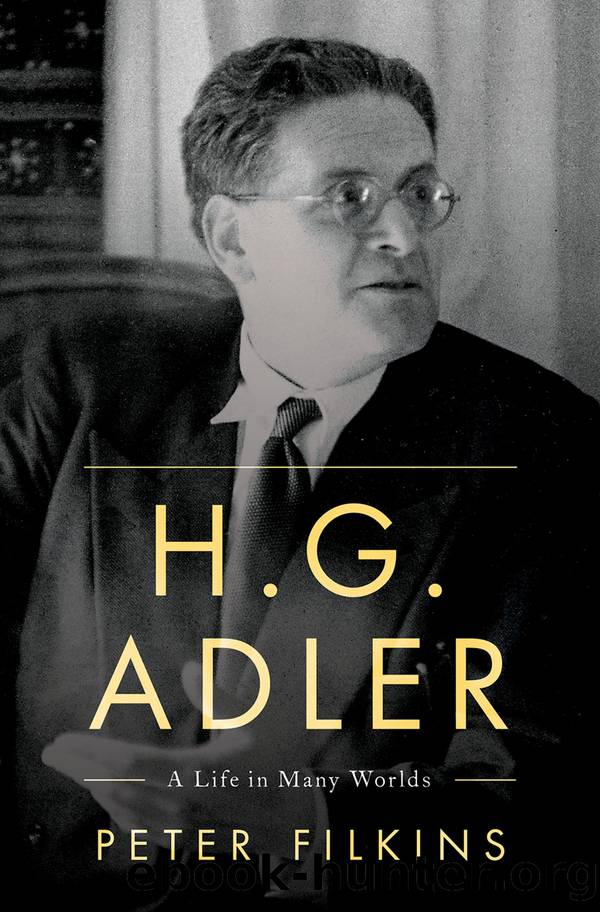H. G. Adler: A Life in Many Worlds by Peter Filkins

Author:Peter Filkins [Filkins, Peter]
Language: eng
Format: epub
Tags: Biography & Autobiography, Literary Figures
ISBN: 9780190222390
Google: JOCGDwAAQBAJ
Publisher: Oxford University Press
Published: 2019-02-12T00:31:09.820552+00:00
12
The Survivor
When Adler landed in London on February 11, 1947, he was met at Croydon Airport in a driving snowstorm by Bettina, Steiner, and Canetti.1 Rather than being allowed to spend his first night with his fiancée, he was whisked off to dinner, hungry and exhausted, by Canetti and Steiner, who were eager to speak to him firsthand about Theresienstadt and the camps. He finally got some sleep in the apartment of Marie-Louise von Motesiczky, an exiled Austrian painter who was Canettiâs lover, which accounts for his wife, Veza, not being there regardless of her and Adlerâs fondness for one another.2 Canetti and Steiner had been in contact with Adler by letter for well over a year, yet seeing him came as a shock, as neither had expected he would survive. Heading off to a Chinese restaurant, their talk turned to their work. Canetti was in the thick of research and writing for his 1960 study Crowds and Power, and Steiner devoted himself to A Comparative Study of the Forms of Slavery, his dissertation at Oxford, which he completed in 1949, despite having lost all his notes and early drafts in a suitcase inadvertently switched for someone elseâs on the train between London and Oxford in 1942. Though Canetti and Steiner started their separate projects in 1939, Adler had with him the nearly finished first draft of Theresienstadt 1941â1945, which set him ahead of them in the completion of a major scholarly response to the Nazi cataclysm, Adler the only one of them to have experienced it directly.3
The gathering marked the first time Adler, Canetti, and Steiner were all together. Restoring their shared ties to a Central European intellectual tradition marked by debate and a deep sense of moral purpose, it also brought together scholarly and literary talents that were deeply interconnected. Canetti and Adler were novelists who had turned to sociological studies of political power gone awry. Canetti and Steiner wrote of their respective travels and cultural observations, while Adler and Steiner worked seriously as poets.4 All three forged a âGesamtkunstwerkâ (âA Single Unified Work of Artâ), a term coined by Richard Wagner and used by Jürgen Serke to describe Adlerâs accomplishment across several genres.5 Moreover, their friendship fueled and shaped their intellects in important ways. Even before Adler arrived in England, he exchanged poems and vigorous commentary with Steiner. During the war Canetti and Steiner were close, Steinerâs thinking on ethnology and myth becoming so influential that some think Canettiâs Crowds and Power could not have been written without it.6 Adler and Canetti would see each other often in London, and although Adler was five years younger, Canetti shared his private thoughts to such an extent that he would later say, somewhat self-servingly, that it was âa sign of my sympathy for him that I had to rein myself in and not tell him everything.â7 Looked at another way, however, it was Adler who told him âeverything.â Signing a 1962 first English edition of Crowds and Power, Canetti wrote: âTo H.
Download
This site does not store any files on its server. We only index and link to content provided by other sites. Please contact the content providers to delete copyright contents if any and email us, we'll remove relevant links or contents immediately.
Machine Learning at Scale with H2O by Gregory Keys | David Whiting(4094)
Never by Ken Follett(3758)
Harry Potter and the Goblet Of Fire by J.K. Rowling(3758)
Unfinished: A Memoir by Priyanka Chopra Jonas(3313)
Fairy Tale by Stephen King(3192)
The Man Who Died Twice by Richard Osman(2977)
Will by Will Smith(2767)
Rationality by Steven Pinker(2271)
The Dark Hours by Michael Connelly(2214)
It Starts With Us (It Ends with Us #2) by Colleen Hoover(2171)
The Storyteller by Dave Grohl(2148)
Can't Hurt Me: Master Your Mind and Defy the Odds - Clean Edition by David Goggins(2142)
The Dawn of Everything: A New History of Humanity by David Graeber & David Wengrow(2103)
Friends, Lovers, and the Big Terrible Thing by Matthew Perry(2097)
The Becoming by Nora Roberts(2058)
The Stranger in the Lifeboat by Mitch Albom(2031)
Cloud Cuckoo Land by Anthony Doerr(2012)
Einstein: His Life and Universe by Walter Isaacson(1952)
Love on the Brain by Ali Hazelwood(1931)
